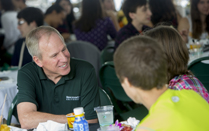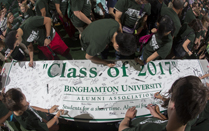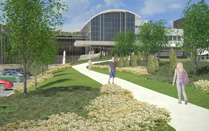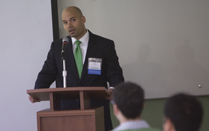Binghamton University President Harvey Stenger’s Quarterly Report – September 30, 2013
Last fall, when the Rankings and Reputation Road Map team said that one of its objectives was to have the President of the United States visit Binghamton University, I would never have predicted that goal would be met so quickly. It has been a very busy three months since my last report, but I have to say the highlight was President Barack Obama’s Town Hall Meeting on Aug. 23, held in our Mandela Room. The national visibility we experienced from that visit is priceless.
President Obama’s message that day was one of affordability and accessibility, and that’s what Binghamton University provides – an affordable education that is accessible to students from all walks of life.
Preparations for a visit by the President of the United States are far-reaching and deep. According to the White House staff and Secret Service, our University was one of the most helpful and cooperative locations they have dealt with. Now, they may just say that at every place they visit, but I think with the number of times they said it, they were sincere and truly appreciated all the work that was done by the administration, University police, our physical facilities staff and our logistics, planning and communications people. I commend them all for making the visit go off without a hitch, and I hope this is not the last presidential visit we experience.
We also played host to Gov. Andrew M. Cuomo twice this summer, once for his introduction of alumnus Gerald Mollen ’74, the Broome County district attorney, as a member of his Moreland Commission to investigate public corruption, and another time to announce his New York Rising community reconstruction meetings to empower local communities as they rebuild following major storms over the past two years.
Two major celebrations also took place recently. The first on Aug. 15 celebrated the opening of the final phase of our $375 million East Campus Housing Project more than a decade after it was first proposed. The project replaced our two oldest residential communities (Newing College and Dickinson Community), adding more than 900 beds to our housing stock. The second celebration was also well-earned: achieving LEED© Platinum certification for our Engineering and Science Building. Now one of only 30 in all of New York state, the building is the third in the SUNY system to earn the highest level of certification for energy efficiencies and sustainability initiatives.
I also recently announced that Pamela Mischen, associate professor of public administration and director of the Center for Applied Community Research and Development, will serve as my faculty advisor. In this new role, she will provide advice and assistance to me in a number of areas, particularly on faculty and community related issues. Initially, she will be conducting a comprehensive community impact assessment that will help us quantify beyond dollar figures, all that we do to make the Southern Tier a desirable place to live, work and raise a family.
We do not slow down during the summer!
Road Map update
In September, I reconvened the Road Map Steering Committee, now reconfigured into five teams with each representing one of the University’s five strategic priorities. There are some new faces on the teams, including administrators, staff, and alumni and foundation board representatives – as well as new “Road Mappers” to help support and guide us. The Road Mappers, a team of student interns, work closely with me and the Steering Committee to help us stay on track. Most of last year’s Road Mappers, all from the School of Management, remain engaged with the process, and we’ve added a few more, this time from Harpur College. The experience these young people gain through their work with such an important project – and the benefits the campus receives from their time and talent – is immeasurable.
The Steering Committee, which will meet quarterly, has been tasked with establishing metrics for the projects under their purview. Each of the five teams will choose five to 10 key performance metrics such as increased graduation rates, graduate enrollment and increased funded research that will clearly indicate we have made progress in their strategic priority. Each team will also select five to 50 measurements that are trend indicators – ones that are highly likely to indicate that a key performance metric will change, such as grade distributions and proposals submitted. The metrics will be finalized by the end of December.
The teams will also shepherd the Road Map projects for their strategic priorities, monitoring progress and collecting reports, always measuring against their established metrics. We’ll use a planning and assessment software called WEAVEonline to help us with some of this. Originally brought into play to help us with a comprehensive, standardized and sustainable assessment and documentation process for our 2016 Middle States accreditation mid-year review, we can use it to guide and align our Road Map processes as well. As we move forward, project results will be posted quarterly on the Road Map website, so watch for updates on the Web in early January.
In the meantime, we have already made rapid progress on a number of our nearly 50 funded Road Map projects. One very public project took a leap forward in August, when I announced that Valerie Hampton, our director of affirmative action, would become the University’s Chief Diversity Officer in our new Office of Diversity, Equity and Inclusion. The mission of this new office is to support the development and implementation of diversity and inclusion initiatives that create a welcoming campus climate that exudes a fundamental respect for human diversity in all its dimensions. Hampton worked closely with me to prepare for the enhanced role and to identify divisional liaisons to assist in implementing this important initiative. The divisional liaisons are Daryl Santos, academic affairs; Joe Schultz, administration; Julia Quigley, advancement; Ed Scott, athletics; Randall Edouard, student affairs; and Lisa Gilroy, research.
Incoming class of students
We welcomed our new students in August, the day before President Obama came to campus and I consider our Move-in Day a great success. (We should actually call it Move-in Week as we welcome international students and early arrivals before our freshmen and transfers, and our returning students after them.) I loved greeting students and parents as they arrived on campus and appreciate all of the planning that went into getting everyone moved in quickly on such a hot day.
Our entering class – about 2,600 freshmen, 1,100 transfer students and 1,100 graduate students – have helped us move toward our goal of enrolling 17,000 students by 2017. For the first time ever, our total enrollment exceeds 16,000, and we are well on our way to meeting the goals set forth in our NYSUNY 2020 plan.
Our freshman class was accepted from a record-high 29,046 applications, and comes to us with a high school GPA of 94 and SAT scores averaging 1908 – making it one of the most academically impressive classes in our history. Our transfers, with a mean GPA of 3.4, include about 225 SUNY Broome students. Another 80 new students are in the Binghamton Advantage Program, a special, dual-admission program with SUNY Broome that allows students to become part of our University community and live on our campus while attending SUNY Broome.
We continue to enroll a diverse class with a geographic distribution that reflects New York state’s population and our diversity is greatly enhanced by our international student population, which continues to grow. With about 400 new international undergraduates and about the same number of new international graduate students, we now enroll over 2,500 international students from 102 countries, up about 150 students from last year.
Faculty hiring
As you will read in Executive Vice President and Provost Donald Nieman’s report, we are ahead of pace to meet the goals of our NYSUNY 2020 faculty hiring plan. As we did in the last academic year, we have hired a large number of quality faculty across all schools and disciplines so we are supporting the fine arts, humanities and social sciences as well as the STEM disciplines.
I can’t overstate the importance of these new faculty, who are energizing and enriching our campus in the three-pronged mission of teaching, research and service that is set before them.
Our five Transdisciplinary Areas of Excellence (TAE) committees truly came alive with activity as the semester began. Several of them met over the summer as well, and their work has begun in earnest as they are heavily involved in the majority of the faculty searches under way for the 2014-15 academic year hiring cycle. In parallel with the searches, these committees are ramping up to host conferences and symposia, as well as to encourage faculty applications for collaborative grant funding that will stimulate and advance new ideas in each of their areas. It is through these TAEs that we will build our expertise and national reputation.
Regional Economic Development and Start-Up NY
I’ve remained very busy co-chairing the Regional Economic Development Council (REDC) with Corning executive Tom Tranter and believe this role exemplifies how we must remain fully invested in the economic health of our region. We have been able to leverage nearly $440 million in investments and create or retain thousands of jobs over the last two years as a result of the REDC process.
Moving forward, we have made our third-round funding proposal and are requesting funding for projects in our region that will result in the creation of 1,400 jobs and the retention of nearly 100 more. One of our current University project requests is for $1.5 million of the $7.5 million needed to help us develop a research-based program that would provide every University undergraduate STEM student with an authentic research experience during their four years on campus. The project requires design, construction and outfitting of new labs to fully integrate our undergraduates into leading-edge research.
The high-tech incubator project, which received $7 million in the second round of REDC funding, has also received $2 million in IDA funding for site development and $2 million from the federal Economic Development Administration. Ashley McGraw Architects is working with community leaders, the neighborhood where the incubator is to be built and us to ensure the incubator project is a success. We expect the site to be shovel ready by the spring, with construction to start later in the year.
We are also working closely with SUNY Broome to identify the highest and best use of available land in the region to support Gov. Andrew Cuomo’s START-UP NY initiative to encourage start-ups to stay in New York state and to attract others from out of state. We know we have to be strategic in how we allocate space, especially as we need to accommodate the growth of our student body and faculty on campus.
Sincerely,

Harvey G. Stenger





